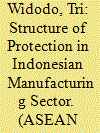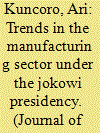|
|
|
Sort Order |
|
|
|
Items / Page
|
|
|
|
|
|
|
| Srl | Item |
| 1 |
ID:
160032


|
|
|
|
|
| Summary/Abstract |
Policy initiatives and regulatory changes made during the last two-and-half decades of economic reforms have led to a considerable increase in the number of mergers and acquisitions (M&As) in the Indian corporate sector. Given the policy-induced flexibilities, while the domestic firms have taken the route of mergers to restructure their business and grow, the foreign firms have preferred to enter into specific markets through acquisitions and raise monopoly power therein. In this context, the present article attempts to examine the impact of M&As on market the structure in major industries of the Indian manufacturing sector during the post-reform period. Using a panel dataset of 34 major industries for the period 2001–2009, the article finds that M&As do not necessarily cause any appreciable adverse impact on market concentration. Instead, the degrees of sellers’ concentration are influenced by the growth of market, capital intensity, firms’ advertising efforts and their financial performance. The findings of the present article, therefore, suggest for a rethink on policies and regulations relating to M&A, international trade and intellectual property, as they play a significant role in enhancing firms’ competitiveness and restricting the emergence of a monopolistic power.
|
|
|
|
|
|
|
|
|
|
|
|
|
|
|
|
| 2 |
ID:
156968


|
|
|
|
|
| Summary/Abstract |
The paper reviews and assesses the performance of the manufacturing sector in general, as well as the catalytic industries identified in the Eleventh Malaysia Plan (11MP), to ascertain whether the initiatives and targets proposed in the Plan are adequate to energize and move the sector forward. In doing so, the paper uses industrial policy arguments — market and government failures — to explain the slow progress of the sector. The findings suggest that market failures — in terms of lagging industrial capabilities and economies of scale, market frictions, lack of support for self-discovery by firms and diversification — require government intervention. Nevertheless, defying comparative advantage and identifying frontier products that show lacklustre performance to spearhead the sector under the Plan certainly require substantial improvements in institutional capabilities, coordination and institutional learning, while maintaining respect for markets and incentives. The paper concludes that lack of recognition to address government failures limited the success of policies implemented.
|
|
|
|
|
|
|
|
|
|
|
|
|
|
|
|
| 3 |
ID:
186390


|
|
|
|
|
| Summary/Abstract |
This research assesses the importance of financial access on value added in three economic sectors in 25 countries in Sub-Saharan Africa using data for the period 1980–2014. The empirical evidence is based on the Generalized Method of Moments. Financial access is measured with private domestic credit, while the three outcome variables are: value added in the agricultural, manufacturing, and service sectors, respectively. Enhancing financial access does not significantly improve value added in the agricultural and manufacturing sectors, while enhancing financial access improves value added in the service sector. An extended analysis shows that, in order for the positive net incidence of enhancing credit access on value added to the service sector to be maintained, complementary policies are required when domestic credit to the private sector is between 77.50 percent and 98.50 percent of GDP. Policy implications are discussed.
|
|
|
|
|
|
|
|
|
|
|
|
|
|
|
|
| 4 |
ID:
159062


|
|
|
|
|
| Summary/Abstract |
The security of property rights has been found to play important roles in various aspects of firm behaviors. However, its effects on firm survival have been largely neglected in previous research. Using annual data of Chinese manufacturing firms over the period 1998–2008, we analyze the link between property rights security and firms' survival probabilities, differentiating firms into stated-owned enterprises (SOEs) and non-SOEs, and considering whether the linkage evolves over time. Examining a wide range of specifications, we find that the protection of property rights, by limiting government intervention and promulgating laws and rules, is crucial for firm survival. Moreover, better security of property rights benefits non-SOEs more. We also find that the beneficial effects of secure property rights on firm survival are more pronounced for years after 2003 when China speeded up deregulation to comply with its WTO commitments and reform target to establish a modern system of property rights than for years before 2002.
|
|
|
|
|
|
|
|
|
|
|
|
|
|
|
|
| 5 |
ID:
083674


|
|
|
|
|
| Publication |
2008.
|
| Summary/Abstract |
This paper aims to analyse structure of protections in Indonesian manufacturing sector. Firstly, it describes the evolution of Indonesian industrial and trade policies. To some extent, Indonesian industrial and trade policies follow a statement of the supporters of liberalization: "good times mean bad policies and bad times mean good policies". Secondly, effective rate of protection analysis shows that Indonesian manufacturing sector has been liberalized more, especially after the 1997 economic crisis. The liberalization in manufacturing sector has also been encouraged by international/regional commitments such as the WTO, IMF, ASEAN Free Trade Agreement and other preferential trade agreements. Thirdly, Indonesian trade liberalization in the manufacturing sector was faster than that of Thailand and could catch up with Malaysian trade liberalization
|
|
|
|
|
|
|
|
|
|
|
|
|
|
|
|
| 6 |
ID:
162535


|
|
|
|
|
| Summary/Abstract |
Indonesia’s manufacturing sector has been transformed from being a driver of economic growth to a sector that is almost completely dependent on the growth of domestic demand. The commodity boom that took place between 2005 and 2012 has resulted in a Dutch disease situation in which the expansion of one sector has reduced the incentive for manufacturing to export, given that domestic demand is readily available. Recent data show that Indonesian manufacturing has been lagging behind its nearest neighbours in reaping the benefits of international value chains. Being more inward-looking, manufacturing now depends on other sectors to generate growth. While some industries such as textiles and automotive are still promising, in order to keep the momentum going on manufacturing exports, Indonesia needs additional reforms including: better logistics; fewer non-tariff barriers; and improved human resource quality.
|
|
|
|
|
|
|
|
|
|
|
|
|
|
|
|
|
|
|
|
|